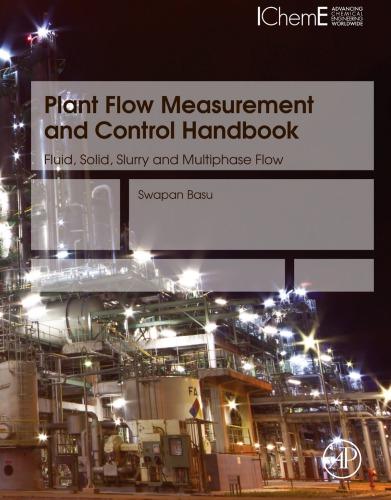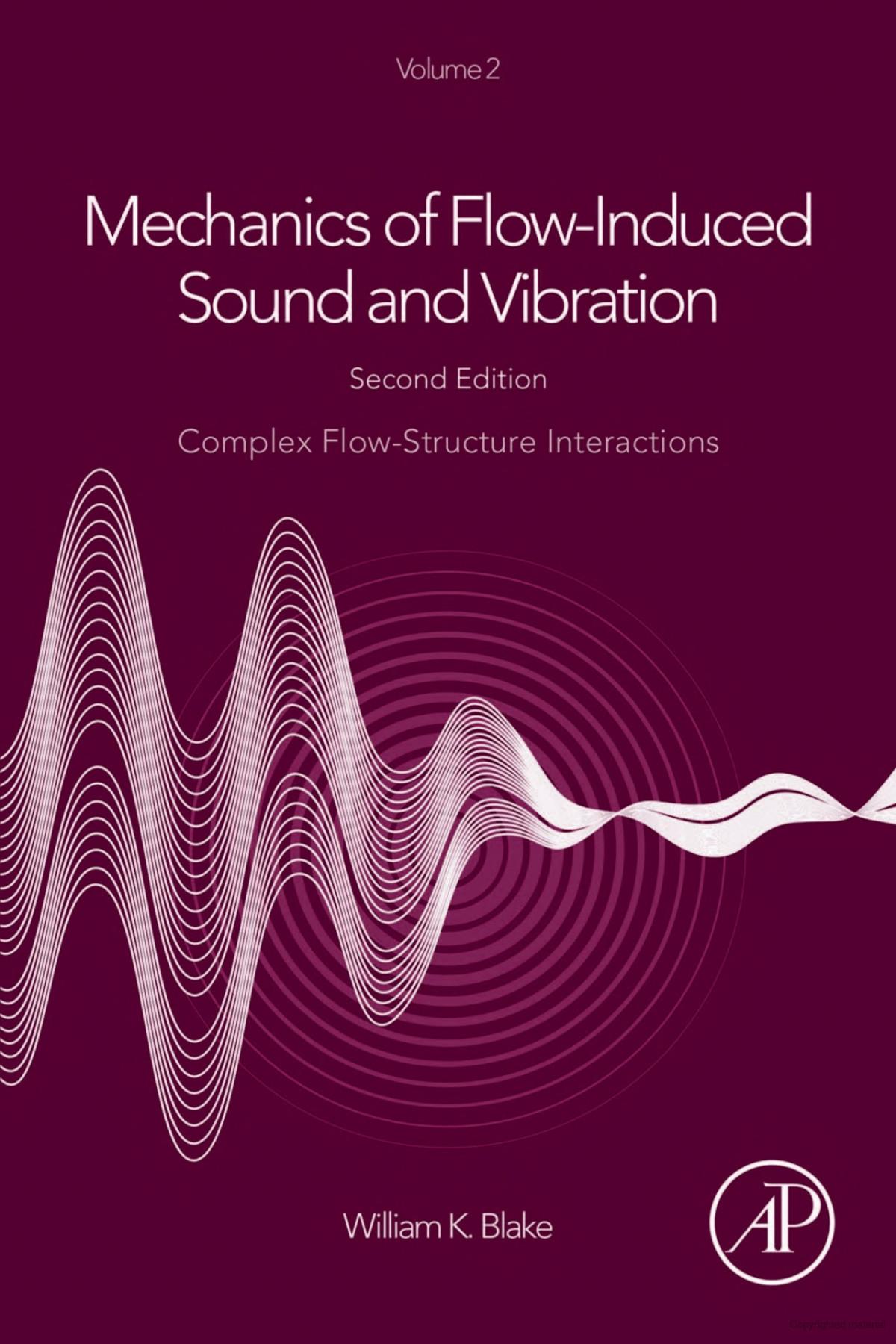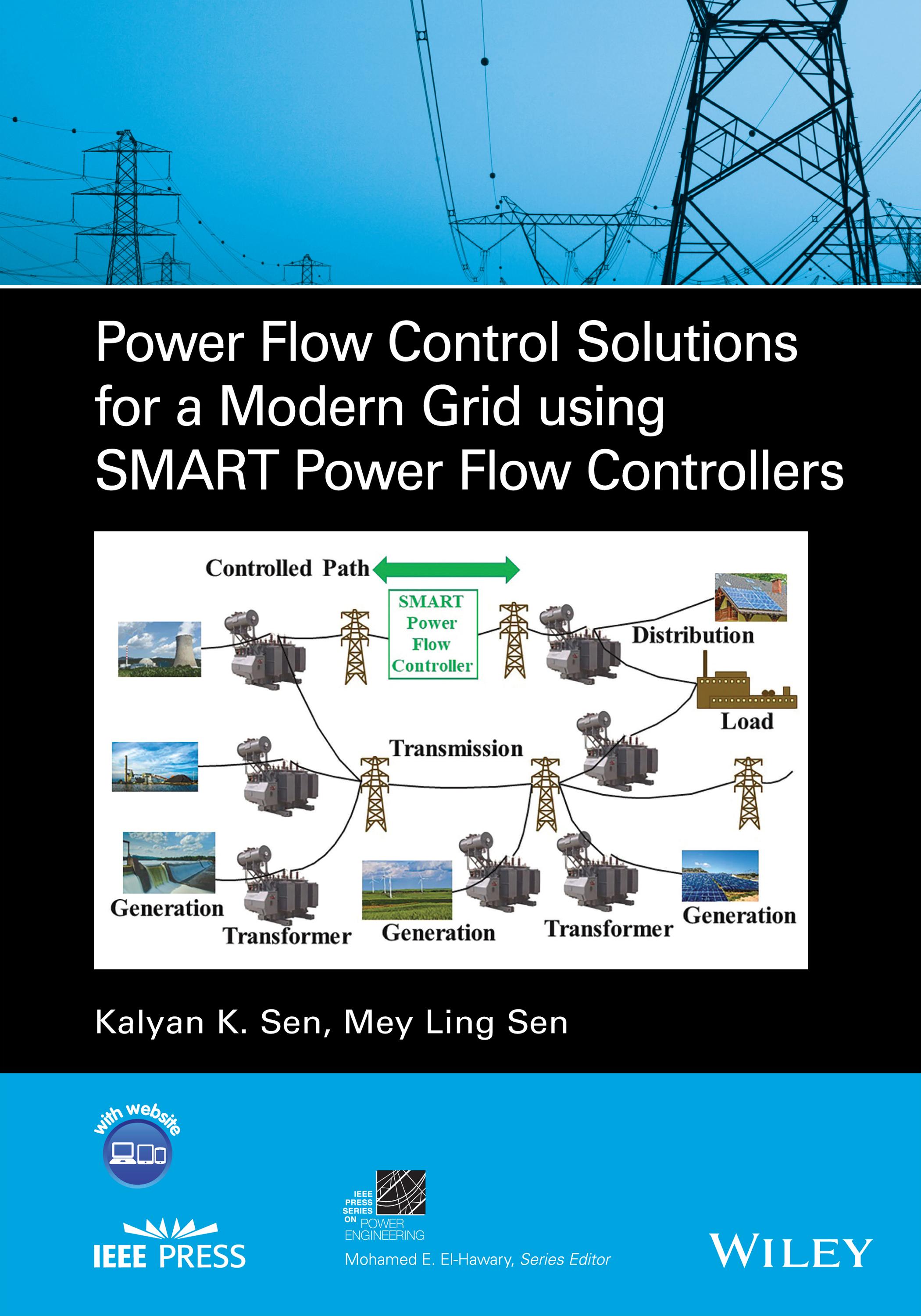Visit to download the full and correct content document: https://ebookmass.com/product/power-flow-control-solutions-for-a-modern-grid-usingsmart-power-flow-controllers-kalyan-k-sen/

More products digital (pdf, epub, mobi) instant download maybe you interests ...

Plant Flow Measurement and Control Handbook 1st Edition
Swapan Basu
https://ebookmass.com/product/plant-flow-measurement-and-controlhandbook-1st-edition-swapan-basu/

Mechanics of Flow-Induced Sound and Vibration Volume 2_ Complex Flow-Structure Interactions 2nd Edition William
K. Blake
https://ebookmass.com/product/mechanics-of-flow-induced-soundand-vibration-volume-2_-complex-flow-structure-interactions-2ndedition-william-k-blake/

Loose Leaf for Modern Compressible Flow: With Historical Perspective 4th Edition John Anderson
https://ebookmass.com/product/loose-leaf-for-modern-compressibleflow-with-historical-perspective-4th-edition-john-anderson/

Advanced Control of Power Converters Hasan Komurcugil
https://ebookmass.com/product/advanced-control-of-powerconverters-hasan-komurcugil/

Modern Compressible Flow With Historical 4th Edition
John D. Anderson Jr
https://ebookmass.com/product/modern-compressible-flow-withhistorical-4th-edition-john-d-anderson-jr/

Flow Analysis for Hydrocarbon Pipeline Engineering
Alessandro Terenzi
https://ebookmass.com/product/flow-analysis-for-hydrocarbonpipeline-engineering-alessandro-terenzi/

Power Plant Engineering R. K. Hegde
https://ebookmass.com/product/power-plant-engineering-r-k-hegde/

Energy Storage for Modern Power System Operations
Sandeep Dhundhara
https://ebookmass.com/product/energy-storage-for-modern-powersystem-operations-sandeep-dhundhara/

Investigation of oil flow in a ball bearing using Bubble Image Velocimetry and CFD modeling Ujjawal Arya
https://ebookmass.com/product/investigation-of-oil-flow-in-aball-bearing-using-bubble-image-velocimetry-and-cfd-modelingujjawal-arya/

IEEEPress
445HoesLane Piscataway,NJ08854
IEEEPressEditorialBoard EkramHossain, EditorinChief
JónAtliBenediktssonXiaoouLiJeffreyReed AnjanBoseLianYongDiomidisSpinellis DavidAlanGrierAndreasMolischSarahSpurgeon ElyaB.JoffeSaeidNahavandiAhmetMuratTekalp
KalyanK.Sen,PhD,PE,MBA,FIEEE
MeyLingSen,MEE,MIEEE
SenEngineeringSolutions,Inc.
Copyright©2022byTheInstituteofElectricalandElectronicsEngineers,Inc.Allrightsreserved.
PublishedbyJohnWiley&Sons,Inc.,Hoboken,NewJersey. PublishedsimultaneouslyinCanada.
Nopartofthispublicationmaybereproduced,storedinaretrievalsystem,ortransmittedinanyformorbyanymeans, electronic,mechanical,photocopying,recording,scanning,orotherwise,exceptaspermittedunderSection107or108 ofthe1976UnitedStatesCopyrightAct,withouteitherthepriorwrittenpermissionofthePublisher,orauthorization throughpaymentoftheappropriateper-copyfeetotheCopyrightClearanceCenter,Inc.,222RosewoodDrive, Danvers,MA01923,(978)750-8400,fax(978)750-4470,oronthewebatwww.copyright.com.Requeststothe PublisherforpermissionshouldbeaddressedtothePermissionsDepartment,JohnWiley&Sons,Inc.,111River Street,Hoboken,NJ07030,(201)748-6011,fax(201)748-6008,oronlineathttp://www.wiley.com/go/permission.
LimitofLiability/DisclaimerofWarranty: Whilethepublisherandauthorhaveusedtheirbesteffortsinpreparingthis book,theymakenorepresentationsorwarrantieswithrespecttotheaccuracyorcompletenessofthecontentsofthis bookandspecificallydisclaimanyimpliedwarrantiesofmerchantabilityorfitnessforaparticularpurpose.No warrantymaybecreatedorextendedbysalesrepresentativesorwrittensalesmaterials.Theadviceandstrategies containedhereinmaynotbesuitableforyoursituation.Youshouldconsultwithaprofessionalwhereappropriate. Further,readersshouldbeawarethatwebsiteslistedinthisworkmayhavechangedordisappearedbetween whenthisworkwaswrittenandwhenitisread.Neitherthepublishernorauthorshallbeliableforanylossofprofitor anyothercommercialdamages,includingbutnotlimitedtospecial,incidental,consequential,orotherdamages.
Forgeneralinformationonourotherproductsandservicesorfortechnicalsupport,pleasecontactourCustomerCare DepartmentwithintheUnitedStatesat(800)762-2974,outsidetheUnitedStatesat(317)572-3993orfax(317) 572-4002.
Wileyalsopublishesitsbooksinavarietyofelectronicformats.Somecontentthatappearsinprintmaynotbe availableinelectronicformats.FormoreinformationaboutWileyproducts,visitourwebsiteatwww.wiley.com.
LibraryofCongressCataloging-in-PublicationData
Names:Sen,KalyanK.,author.|Sen,MeyLing,author.
Title:PowerflowcontrolsolutionsforamoderngridusingSMARTpower flowcontrollers/KalyanK.Sen,PhD,PE,MBA,FIEEE,MeyLingSen, MEE,MIEEE,SenEngineeringSolutions,Inc.
Description:Firstedition.|Hoboken,NewJersey:JohnWiley&Sons, Inc.,[2021]|Series:IEEEpressseriesonpowerengineering|Includes bibliographicalreferencesandindex.
Identifiers:LCCN2021031547(print)|LCCN2021031548(ebook)|ISBN 9781119824350(hardback)|ISBN9781119824367(adobepdf)|ISBN 9781119824381(epub)
Subjects:LCSH:Electriccurrentregulators.|Electricpower systems–Control.|Smartpowergrids.|ElectricpowerTransmission.
Classification:LCCTK2851.S482021(print)|LCCTK2851(ebook)|DDC 621.31–dc23
LCrecordavailableathttps://lccn.loc.gov/2021031547
LCebookrecordavailableathttps://lccn.loc.gov/2021031548
CoverDesign:Wiley
CoverImages:(Center)CourtesyofKalyanSen;(top)©SamRobinson/GettyImages Setin9.5/12.5ptSTIXTwoTextbyStraive,Pondicherry,India 10987654321
Toourfamily,friends, andallourguruswhobroughtustothispoint.
Contents
Authors’ Biographies xiii
Foreword xv
Nomenclature xix
Preface xxv
Acknowledgments xxix
AbouttheCompanionWebsite xxxi
1SmartControllers 1
1.1WhyisaPowerFlowControllerNeeded? 1
1.2TraditionalPowerFlowControlConcepts 5
1.3ModernPowerFlowControlConcepts 14
1.4CostofaSolution 22
1.4.1DefiningaCost-EffectiveSolution 22
1.4.2PaybackTime 24
1.4.3EconomicAnalysis 24
1.5IndependentActiveandReactivePFCs 26
1.6SMARTPowerFlowController(SPFC) 39
1.6.1ExampleofanSPFC 40
1.6.2Justification 41
1.6.3AdditionalInformation 41
1.7Discussion 42
2PowerFlowControlConcepts 45
2.1PowerFlowEquationsforaNaturalorUncompensatedLine 60
2.2PowerFlowEquationsforaCompensatedLine 63
2.2.1Shunt-CompensatingVoltage 67
2.2.1.1PowerFlowattheModifiedSendingEndwithaShunt-CompensatingVoltage 70
2.2.1.2PowerFlowattheReceivingEndwithaShunt-CompensatingVoltage 73
2.2.1.3ExchangedPowerbyaShunt-CompensatingVoltage 79
2.2.1.4RepresentationofaShunt-CompensatingVoltageasaShunt-Compensating Impedance 79
2.2.2Series-CompensatingVoltageasanImpedanceRegulator,VoltageRegulator,andPhase AngleRegulator(Asymmetric) 80
2.2.2.1PowerFlowattheSendingEndwithaSeries-CompensatingVoltage 92
2.2.2.2PowerFlowattheReceivingEndwithaSeries-CompensatingVoltage 95
2.2.2.3PowerFlowattheModifiedSendingEndwithaSeries-CompensatingVoltage 100
2.2.2.4ExchangedPowerbyaSeries-CompensatingVoltage 109
2.2.2.5AdditionalSeries-CompensatingVoltages 126
2.2.2.5.1PhaseAngleRegulator(Symmetric) 126
2.2.2.5.2ReactanceRegulator 129
2.2.2.5.2.1ReactanceControlMethod 137
2.2.2.5.2.2VoltageControlMethod 139
2.2.2.6RepresentationofaSeries-CompensatingVoltageasaSeries-Compensating Impedance 145
2.2.2.6.1EquivalentImpedanceofaVoltageRegulator(VR) 152
2.2.2.6.2EquivalentImpedanceofaPhaseAngleRegulator(Asymmetric) 154
2.2.2.6.3EquivalentImpedanceofaPhaseAngleRegulator(Symmetric) 157
2.2.2.6.4EquivalentImpedanceofaReactanceRegulator 160
2.2.3ComparisonBetweenSeries-andShunt-CompensatingVoltages 165
2.3ImplementationofPowerFlowControlConcepts 168
2.3.1VoltageRegulation 168
2.3.1.1DirectMethod 168
2.3.1.2IndirectMethod 170
2.3.2PhaseAngleRegulation 173
2.3.2.1Single-corePhaseAngleRegulator 173
2.3.2.2Dual-corePhaseAngleRegulator 176
2.3.3SeriesReactanceRegulation 178
2.3.3.1DirectMethod 178
2.3.3.2IndirectMethod 178
2.3.4ImpedanceRegulation 179
2.3.4.1UnifiedPowerFlowController(UPFC) 181
2.3.4.2SenTransformer(ST) 183
2.4InterlinePowerFlowConcept 185
2.4.1Back-to-BackSSSC 186
2.4.2MultilineSenTransformer(MST) 188
2.4.3Back-to-BackSTATCOM 192
2.4.4GeneralizedPowerFlowController 194
2.5FigureofMeritsAmongVariousPFCs 196
2.5.1VR 196
2.5.2PAR(sym) 196
2.5.3PAR(asym) 198
2.5.4RR 202
2.5.5IR 204
2.5.6 RPI, LI,and APR ofaPFC 206
2.6ComparisonBetweenShunt-CompensatingReactanceandSeries-Compensating Reactance 228
2.6.1Shunt-CompensatingReactance 230
2.6.1.1RestorationofVoltageattheMidpointoftheLine 230
2.6.1.2RestorationofVoltageattheOne-ThirdandTwo-ThirdPointsoftheLine 232
2.6.1.3RestorationofVoltageattheOne-Fourth,Half,andThree-FourthPointsofthe Line 233
2.6.1.4RestorationofVoltageat n PointsoftheLine 235
2.6.2Series-CompensatingReactance 239
2.7Calculationof RPI, LI,and APR foraPAR(sym),aPAR(asym),aRR,andanIRinaLossy Line 242
2.7.1PAR(sym) 245
2.7.2PAR(asym) 246
2.7.3RR 248
2.7.4IR 249
2.8 SenIndex ofaPFC 253
3ModelingPrinciples 255
3.1TheModelinginEMTP 255
3.1.1ASingle-Generator/Single-LineModel 259
3.1.2ATwo-Generator/Single-LineModel 264
3.2VectorPhase-LockedLoop(VPLL) 277
3.3TransmissionLineSteady-StateResistanceCalculator 280
3.4SimulationofanIndependentPFC,IntegratedinaTwo-Generator/Single-LinePower SystemNetwork 281
4Transformer-BasedPowerFlowControllers 297
4.1Voltage-RegulatingTransformer(VRT) 297
4.1.1VoltageRegulatingTransformer(Shunt-SeriesConfiguration) 298
4.1.2Two-WindingTransformer 315
4.2PhaseAngleRegulator(PAR) 322
4.2.1PAR(Asymmetric) 322
4.2.2PAR(Symmetric) 332
5Mechanically-SwitchedVoltageRegulatorsandPowerFlowControllers 341
5.1ShuntCompensation 341
5.1.1Mechanically-SwitchedCapacitor(MSC) 341
5.1.2Mechanically-SwitchedReactor(MSR) 353
5.2SeriesCompensation 354
5.2.1Mechanically-SwitchedReactor(MSR) 354
5.2.2Mechanically-SwitchedCapacitor(MSC)withaReactor 363
5.2.3SeriesReactanceEmulator 369
6SenTransformer 375
6.1ExistingSolutions 377
6.1.1VoltageRegulation 383
6.1.2PhaseAngleRegulation 385
6.2DesiredSolution 386
6.2.1STasaNewVoltageRegulator 389
6.2.2STasanIndependentPFC 392
6.2.3ControlofST 394
6.2.3.1ImpedanceEmulation 395
6.2.3.2ResistanceEmulation 396
6.2.3.3ReactanceEmulation 396
6.2.3.4Closed-LoopPowerFlowControl 397
6.2.3.5Open-LoopPowerFlowControl 398
6.2.4SimulationofSTIntegratedinaTwo-Generator/One-LinePowerSystemNetwork 425
Contents
6.2.5SimulationofSTIntegratedinaThree-Generator/Four-LinePowerSystem Network 439
6.2.6TestingofST 453
6.2.7Limited-AngleOperationofST 485
6.2.8STUsingLTCswithLowerCurrentRating 498
6.2.9STwithaTwo-CoreDesign 501
6.3ComparisonAmongtheVRT,PAR,UPFC,andST 510
6.3.1PowerFlowEnhancement 510
6.3.2SpeedofOperation 511
6.3.3Losses 512
6.3.4SwitchRating 512
6.3.5MagneticCircuitDesign 513
6.3.6OptimizationofTransformerRating 513
6.3.7HarmonicInjectionintothePowerSystemNetwork 515
6.3.8OperationDuringLineFaults 515
6.4MultilineSenTransformer 516
6.4.1BasicDifferencesBetweentheMSTandBTB-SSSC 519
6.5FlexibleOperationoftheST 520
6.6STwithaShunt-CompensatingVoltage 522
6.7LimitedAngleOperationoftheSTwithShunt-CompensatingVoltages 526
6.8MSTwithShunt-CompensatingVoltages 531
6.9GeneralizedSenTransformer 532
6.10Summary 533
AppendixAMiscellaneous 535
A.1Three-PhaseBalancedVoltage,Current,andPower 535
A.2SymmetricalComponents 538
A.3SeparationofPositive-,Negative-,andZero-SequenceComponentsinaMultiple FrequencyCompositeVariable 544
A.4Three-PhaseUnbalancedVoltage,Current,andPower 547
A.5d-qTransformation(3-PhaseSystem,Transformedintod-qaxes;d-axisIsthe ActiveComponentandq-axisIstheReactiveComponent) 551
A.5.1ConversionofaVariableContainingPositive-,Negative-,andZero-Sequence Componentsintod-qFrame 556
A.5.2CalculationofInstantaneousPowerintod-qFrame 560
A.5.3CalculationofInstantaneousPowerintod-qframeforaThree-Phase,Three-Wire System 560
A.6FourierAnalysis 566
A.7Adams-BashforthNumericalIntegrationFormula 569
AppendixBPowerFlowEquationsinaLossyLine 571
B.1PowerFlowEquationsforaNaturalorUncompensatedLine 575
B.2PowerFlowEquationsforaCompensatedLine 582
B.2.1Shunt-CompensatingVoltage 583
B.2.1.1PowerFlowattheModifiedSendingEndwithaShunt-Compensating Voltage 584
B.2.1.2PowerFlowattheReceivingEndwithaShunt-CompensatingVoltage 587
B.2.1.3ExchangedPowerbyaShunt-CompensatingVoltage 590
B.2.1.4RepresentationofaShunt-CompensatingVoltageasaShunt-Compensating Impedance 590
B.2.2Series-CompensatingVoltageasanImpedanceRegulator,VoltageRegulator, andPhaseAngleRegulator(Asymmetric) 591
B.2.2.1PowerFlowattheSendingEndwithaSeries-CompensatingVoltage 596
B.2.2.2PowerFlowattheReceivingEndwithaSeries-CompensatingVoltage 600
B.2.2.3PowerFlowattheModifiedSendingEndwithaSeries-Compensating Voltage 606
B.2.2.4ExchangedPowerbyaSeries-CompensatingVoltage 615
B.2.2.5AdditionalSeries-CompensatingVoltages 624
B.2.2.5.1PhaseAngleRegulator(Symmetric) 624
B.2.2.5.2ReactanceRegulator 628
B.2.2.6RepresentationofaSeries-CompensatingVoltageasaSeries-Compensating Impedance 631
B.2.2.6.1EquivalentImpedanceofaVoltageRegulator(VR) 635
B.2.2.6.2EquivalentImpedanceofaPhaseAngleRegulator(Asymmetric) 636
B.2.2.6.3EquivalentImpedanceofaPhaseAngleRegulator(Symmetric) 638
B.2.2.6.4EquivalentImpedanceofaReactanceRegulator 640
B.2.2.7 RPI, LI,and APR ofaPFC 640
B.3DescriptionsoftheExamplesinChapter2 644
AppendixCModelingoftheSenTransformerinPSS®E 647
C.1SenTransformer 647
C.2ModelingwithTwoTransformersinSeries 648
C.3RelatingtheSenTransformerwiththePSSE®EModel 649
C.4ChileanCaseStudy 650
C.5Limitations – PSS®ETwo-TransformerModel 654
C.6Conclusion 655
References 657
Index 669
Authors’ Biographies

KalyanK.Sen wasborninBankura,WestBengal,India. HereceivedBEE(firstclasshonors,1982),MSEE(1983),andPhD degrees(1987),allinElectricalEngineering,from Jadavpur University (India), TuskegeeUniversity (USA),and WorcesterPolytechnicInstitute (USA),respectively.HealsoreceivedanMBA (2012)from RobertMorrisUniversity (USA).HeisthePresident andChiefTechnologyOfficerofSenEngineeringSolutions,Inc. (www.sentransformer.com).From1987to1990,hewasanAssistant ProfessoratPrairieViewA&MUniversity.From1990to2020,he workedmostlyatWestinghouseanditssuccessorcompaniesin theUnitedStates,exceptduring1999–2001whenheworkedat ABBinSweden.HewasakeymemberoftheFlexibleAlternatingCurrentTransmissionSystems (FACTS)developmentteamatWestinghouseScience&TechnologyCenterforwhichhebecamea WestinghouseFellowEngineer.Hecontributedtotheconceptdevelopment,simulation,design, andcommissioningofFACTSprojectsatWestinghousesincetheirinceptionsinthe1990s.He conceivedsomeofthebasicconceptsinpowerflowcontroltechnologyforwhichhewaselevated totheInstituteofElectricalandElectronicsEngineers(IEEE)Fellowgradewiththecitation: for thedevelopmentandapplicationofpowerflowcontroltechnology
Kalyanhasauthoredorcoauthoredmorethan25peer-reviewedpublications,8issuedpatents,2 books,and3bookchaptersintheareasofpowerflowcontrolandpowerelectronics.Heisthe coauthorofthebooktitled, IntroductiontoFACTSControllers:Theory,Modeling,andApplications , IEEEPressandJohnWiley&Sons,Inc.2009,whichisalsopublishedinChineseandIndian (English)paperbackeditions.Thisbookisusedinuniversitiesandindustriesworldwide.Hisinterestsareinpowerconverters,controlsystems,electricalmachines,andpowersystemsimulations andstudies.HeisalicensedProfessionalEngineerinPennsylvaniaandNewYork.Healsoserved asaFulbrightSpecialist(sponsoredbytheU.S.Government)andGlobalInitiativeofAcademic Networks(GIAN)Scholar(sponsoredbytheGovernmentofIndia).Heisanindividualmember ofCIGRE.
Kalyanhasservedmanyorganizations.HehasbeenservingasanIEEEPower&EnergySociety (PES)DistinguishedLecturersince2002.Inthatcapacity,hehasgivenpresentationsonpowerflow controltechnologymorethan150timesin15countries.HeisanAdComMemberofthePower ElectronicsSociety(PELS)andservesasthePELSRegions1-6Chair.HeistheIEEEDivisionII RepresentativetotheBoardofGovernorsofSocietyonSocialImplicationsofTechnology(SSIT) andservesastheChaptersCommitteeChair.HealsoservesastheChairofIEEEPittsburghSSIT
Chapter.In2003,hereestablishedthePittsburghChaptersofthePESandtheIndustryApplications Society(IAS).BothChaptersreceivedthe “OutstandingLargeChapter” awardsfortheiractivities in2004.HeservedastheFoundingChairofIEEEPittsburghPELSChapterthatreceivedthe BestChapterAwardin2015.UnderhisChairmanship,theIEEEPittsburghSectionreceived the “OutstandingLargeSection” awardforitsactivitiesin2005.HeservedasanEditorofthe IEEE TransactionsonPowerDelivery from2002to2007.HeservedastheTechnicalProgramChairofthe 2008PESGeneralMeetinginPittsburgh,andtheChaptersandSectionsActivitiesTrackChairat the2008IEEESectionsCongressinQuebecCity,Canada.HehasservedastheSpecialEventsChair oftheIEEEPittsburghSectionforadecade.HereceivedtheIEEEPittsburghSection Outstanding VolunteerService AwardandPower&EnergySociety OutstandingEngineer Award(2004).He isaDistinguishedToastmaster(DTM)wholedDistrict13ofToastmastersInternational(TI)asits Governortobethe10th-rankingDistrictintheworldin2007–2008.HehasbeenservingasaBoy ScoutsofAmericaLeaderforalmostadecade.

MeyLingSen wasborninAruba,DutchCaribbean.Shereceived BSEE(highdistinction,1988)andMEE(1990)degreesfrom Worcester PolytechnicInstitute (USA)and RiceUniversity (USA),respectively.As anEngineeringConsultant,sheworkedatABBandWestinghouse/ CW.SheistheCo-FounderandChiefOperatingOfficerofSenEngineeringSolutions,Inc.Sheistheco-inventoroftheSenTransformer, whichisusedasaSpecific,Measurable,Attainable,Relevant,and Time-bound(SMART)PowerFlowControllerthatisbasedonfunctionalrequirementsandacost-effectivesolution.Herinterestsarein powerelectronics,electricalmachines,andelectricpowerengineering. AsamemberofIEEE,shehasservedthePittsburghChaptersofPESandIASinvariouspositions,includingChapterChair.BothChaptersreceivedthe “ OutstandingLargeChapter ” awards fortheiractivitiesin2008and2009,respectively.ShealsoservedIEEEPittsburghSectionasthe Treasurerin2012andChairofWomeninEngineeringin2016and2018 –2019.ShehasbeenservingastheSpecialEventsChairoftheIEEEPittsburghSectionsince2020.ShereceivedIEEE PittsburghSectionPower&EnergySociety OutstandingEngineer Award(2018).SheisaDistinguishedToastmaster(DTM).SheservedastheTI ’ sPresident’ sDistinguishedAreaGovernorin 2007 – 2008.
TechnicalReviewers
J.M.DeSalvo
A.Parsotam
B.Shperling
Foreword
Thisbookisaproductoftheauthors’ fivedecadesofcombinedexperiencesintheresearchand developmentofpowerflowcontroltechnology.Thetraditionalpowergridasweknowitischangingdrastically.Mega-sizedwindandsolarprojectsarebeingintegratedintothetraditionalmajoritycarbon-basedpowergridinordertocurbtheproductionofgreenhousegasessignificantly.
Powersystemsoftodayweredesignedbasedoncentralgeneratingstationsandtransmissionand distributionlinestogettheenergytotheloads.However,withland-basedandoff-shorewindplants anddistributedandutility-scalesolarplantsbeingconnectedtothegrid,theoldparadigmdoesnot worksincethegeographiclocationsoftherenewableresourcesdonotingeneralcoincidewiththe traditionalgeneratingplants.ThereisaneedfortheT&Dsystemstoberevisitedandmodified/ upgradedforthenewpowerflowregimes.Thelineimpedancesthatweretunedoroptimizedto servecertainflowpatternsmaynowhinderdeliveryoftherenewableenergytothedesireddestinations.Theintermittentnatureoftherenewableenergysourcesbringsadditionalchallengesto systemfrequencyandvoltagecontrolandtoadoptingtheneededdynamiccapabilityandtheability tocontrolpowerflowsbidirectionallyattherightprice.Thiscanbemitigatedwithimpedanceregulationinstrategically-selectedtransmissioncorridors.Furthermore,inmanylocalitiesthereare nonewright-of-ways(ROWs),andrebuildingislimitedtoexistingones.Eventhoughrebuildcould beinevitable,flowcontrolmayhelpinsomescenariosandmaybemuchmoreeconomical.
Thekeytoacleanenergytransitiondependsontheelectricgrid’sabilitytogenerateanddistributerenewableenergythroughthetransmissionanddistributionsystem.Theintermittencyofsupplyandbidirectionalflows,coupledwiththeremotelocationsofsolarandwindprojects,are challenginggridplannersandoperators.Evenbeforewehavereachedlargepenetrationofrenewables,forecastersarefactoringrenewablecurtailmentasamajorstrategytobalancesupplyand demand,whichadverselyimpactstheeconomicsoftheprojects.
TheconceptofaSMARTPowerFlowController,developedinthisbook,isbasedonimpedance managementofthetransmissionline,whichwillbeessentialto(1)buildingthecapacitytointegrateandexpandtheuseofcleandistributedenergyresources,(2)pursuingefficientassetutilizationandreducingsystemlosses,(3)facilitatinggreatertransferofcleanenergyfromgeneration sitestoloadcenters,and(4)improvinggridreliabilityandresiliency.Thistechnologycanbecustomized,basedontherequiredrangeandspeedofoperation,componentnon-obsolescence,easeof relocation,andinteroperability.
ThisbookstartswiththederivationofthefundamentalsofpowerflowinanACtransmissionline anddevelopsvarioussolutionsthatcanbeusedtoenhancepowerflowwhilereducingthelossesin ACtransmissionlines.ThebookbuildsontheevolutionofpowerflowcontrollersinACtransmissionsystemscoveringthetheory,modeling,andvariousapplications.Thesubjectistreatedfrom
theworkingengineers’ pointofview.Afterreadingtheappropriatepartsofthisbook,students, teachers,andpracticingengineerswillbeabletoconductstudiesofpowersystemnetworksto mitigatetheiruniquepowerflowproblems.
Thebook’suniquecontributionisthatit
• providesthebasictheoryandthestep-by-stepexplanationofvariouspowerflowcontrollers;
• offersmodelingtechniquesthatareessentialtoelectricutilitieswhenconductingtheneeded studiesandanalysis;
• providescomputercodesinthemostwidely-usedElectro-MagneticTransientsProgram(EMTP) formats;
• describesanewclassofpowerflowcontrollers,basedonthetransformers/LoadTapChangers (LTCs)technology,developedbytheauthorsandnamedtheSenTransformer(ST).
ItisimportanttoemphasizethattheSTofferstheequivalentcontrolfeaturesoftwodevices –PhaseAngleRegulator(PAR)andVoltageRegulator(VR) – foralmostthepriceofone.IfonepurchasesaPAR,whichoffersthephaseangleoractivepowerflowcontrolonly,theSToffersthe addedvoltageorreactivepowerflowcontrolcapabilitywithperhapsasmalladditionalcost. Thelow-costpowerflowcontroltechnology,suchasST,isofinteresttoutilitiesbecauseofits simplicity,comparedtopowerelectronicsinverter-basedUnifiedPowerFlowController.
IbelievethattheSens’ inventionsarefundamentalcontributionstowardtheadvancementof low-costelectricpowerflowcontroltechnology.AsimulationmodeloftheSThasalreadybeen developedinPSS/E,themostwidelyusedloadflowsoftware,andthereportisgivenin AppendixC.AsanapplicationexampleexercisingthePSS/Emodel,itwasverifiedthattheSTperformedasthemostsuitablecandidateforpowerflowenhancementinasegmentoftheChilean network.Also,adistribution-levelChinesedemonstrationofa10-kVunitofSTconfirmedthe anticipatedperformanceoftheST.
Thetopicofpowerflowcontrolisofgreatinteresttomanypowerengineeringprofessionals,utilityengineers,largepowerequipmentmanufacturers,universityprofessors,andstudents.Thespecialtyofthebookisthatitdevelopsthemodernpowerflowcontroltheoriesfromthebasicsand supplementsthetheorywithrelevantcomputermodelsusingthemostwidelyusedsimulation software – EMTPandPSS/E.Thisbookexpandsuponwhattheauthorshadpresentedintheirlast book,titled IntroductiontoFACTSControllers – Theory,Modeling,andApplications. Insummary,thesubjectofpowerflowcontrolcannotbeoverstressed;itisaveryimportanttopic totheelectricpowerindustryandelectricutilities,particularlyintoday’senvironment.Duetothe currentneedforintegratingrenewableenergysourcesintothegridreliablytoreducethecarbonbasedgeneration,electricutilitiesareseriouslyconsideringallavailabletechnicalsolutions.Thisis atimelybookthatgivesthereaderclearinstructionsonhowtomodel,design,build,andevaluate powerflowcontrollers.Itsupplementsnicelytheveryfewexistingbooks.Irealizethatthisbookis practical,hands-on,andatrueguideforthepracticingengineers.Thebookgivessignificant amountsofdetailinmodelingandpresentationthatwillbemuchappreciatedbyresearchers/engineersinthefield.
Sincethe1990s,IhavebeeninteractingwithDr.KalyanSenonFlexibleAlternatingCurrent TransmissionSystems(FACTS)-relatedprojects.AstheLeadSimulationEngineeratWestinghouse,Dr.SendevelopedtheFACTSmodels,whichwereessentialforperformingthefeasibility studyoftheConvertibleStaticCompensator(CSC)FACTSprojectbeforeitsinstallationatthe NewYorkPowerAuthority(NYPA)Marcy345kVsubstationincentralNY.
Ihavereadthisbookwithgreatinterest.Itisaworkoflove,writtenbytwospouseswhospent theirentirecareersindevelopingamuch-neededpowerflowcontroltechnologythatcanhelp
Foreword xvii
utilitiesworldwidetoplanandoperatetheirpowergrids.ThespecialtyoftheSens’ bookisthatit iscoauthoredbyanengineerwhoactuallydesignedandcommissionedanumberofpower electronics-basedFACTScontrollersatWestinghousesincetheirinceptionsinthe1990s.Therefore,thebookincludesaflavorofpracticalrelevance.Thisbookisgoingtoaidthetransformational changethatistakingplaceintheelectricutilityindustryworldwide.
WhitePlains,NewYork
BruceB.FardaneshPh.D., IEEELifeFellow VicePresident,SystemPlanning&Analysis NewYorkPowerAuthority
Nomenclature
β Relativephaseangleoftheseries-compensatingvoltagewithrespecttothe sending-endvoltage
δs Phaseangleofthevoltageatthesendingendofaline
δr Phaseangleofthevoltageatthereceivingendofaline
δ Powerangle(differenceofphaseanglesofthevoltagesatthetwoendsofaline)
δ Modifiedpowerangle(differenceofphaseanglesofthevoltagesatthetwo endsofalineaftercompensation)
δ l Lowestmodifiedpowerangle
δ h Highestmodifiedpowerangle
ε Leasterrorofthecalculatedvoltageandactually-tappedvoltageintheSen Transformer
θ Phase-lockedloop(PLL)angle
θ I Phaseangleofthelinecurrent
θ VX Phaseangleofthevoltageacrossthelinereactance
ο Degree
φ Powerfactorangle
ϕ Phaseanglebetweenthevoltageacrossthelinereactanceandthevoltage differencebetweenthesendingandreceivingends
ω Angularfrequency
ψ Phase-shiftangleofthemodifiedsending-endvoltagewithrespecttothe sending-endvoltage
Ω Unitofresistance,reactance,andimpedance
a1-b1-c1 Series-compensatingwindingsinthe A phaseofST
a2-b2-c2 Series-compensatingwindingsinthe B phaseofST
a3-b3-c3 Series-compensatingwindingsinthe C phaseofST
A-B-CExciterwindingsofST
A1-B1-C1 Shunt-compensatingwindingsinthe A phaseofST
A2-B2-C2 Shunt-compensatingwindingsinthe B phaseofST
A3-B3-C3 Shunt-compensatingwindingsinthe C phaseofST
AAmpere(unitofcurrent)
ACAlternatingCurrent
ANSIAmericanNationalStandardsInstitute
apr Instantaneousapparentpowerrating
APR ApparentPowerRating
ATCAvailableTransferCapability
b Multiplierof VXn from0to1
BPSBulkPowerSystem
BTB-SSSCBack-To-BackSSSC
BTB-STATCOMBack-To-BackSTATCOM
BYPBRKBypassbreaker
C Capacitance
cos(φ)Powerfactor
cp CompensatingpointsoftheSenTransformer
CSCConvertibleStaticCompensator
cr, cs , cse Intercept
dDutycycle
DCDirectCurrent
DCLSDCLinkSwitch
E Shunt-orseries-connectedvoltage
EHVExtraHighVoltage
ESElectronicSwitch
FFarad(unitofcapacitance)
FACTSFlexibleAlternatingCurrentTransmissionSystems
FCFixedCapacitor
GaNGalliumNitride
GHGGreen-HouseGas
GPFCGeneralizedPowerFlowController
GSTGeneralizedSenTransformer
GTOGate-TurnOff
HHenry(unitofinductance)
HVHighVoltage
HzHertz(unitoffrequency)
i Instantaneouscurrent,suchaslinecurrent(i),excitingcurrent(iex),sendingendcurrent(is),sourcecurrent(isrc),andsoon
I Linecurrentmagnitude
I Linecurrent
IBRInverter-BasedResource
IECInternationalElectrotechnicalCommission
IEEEInstituteofElectricalandElectronicsEngineers
Iex
ExcitercurrentthroughtheprimarywindingoftheSenTransformer
IPFCInterlinePowerFlowController
In Naturallinecurrentmagnitude
IRImpedanceRegulator
Is Currentatthesendingendoftheline
Isrc Sourcecurrent
ITCR
CurrentthroughThyristor-ControlledReactor
k NumberofTCSCsections
kHzKiloHertz(unitoffrequency)
kR Factor,representingtheratiooflineresistance, R,whenlinecurrentis I and thelineresistance, Rn,whenlinecurrentis In.
L Inductance
LTCLoadTapChanger
LVLowVoltage
MCMagneticCircuit
mr, ms , mse Slope
msMillisecond
MSTMultilineSenTransformer
MvarMegaVAR(unitofreactivepower)
n (subscript)Natural
NCNormally-Closed
NERCNorthAmericanElectricReliabilityCorporation
NONormally-Open
p Three-phaseinstantaneousactivepower
P Activepower
PARPhaseAngleRegulator
Plinen Powerlossinthenaturaloruncompensatedline
Plink Activepoweronthecommonlink
Pr Activepoweratthereceivingendoftheline
Prh Highestactivepoweratthereceivingendoftheline
Prl Lowestactivepoweratthereceivingendoftheline
Prn Naturalactivepoweratthereceivingendoftheline
Ps Activepoweratthesendingendoftheline
Pse ExchangedactivepowerbyaSeriesUnit
Psh ExchangedactivepowerbyaShuntUnit
Psn Naturalactivepoweratthesendingendoftheline
Psrc Activepoweratthesource
Ps Activepoweratthemodifiedsendingendoftheline
PFCPowerFlowController
POCPointofConnectiontotheutility
PSTPhase-ShiftingTransformer
puPerunit
q Three-phaseinstantaneousquadraturepower
QQualityfactor
Q Reactivepower
QBQuadratureBooster
Qlinen Reactivepowerabsorbedbythenaturaloruncompensatedline
Qlink Reactivepoweronthecommonlink
Qr Reactivepoweratthereceivingendoftheline
Qrh Highestreactivepoweratthereceivingendoftheline
Qrl Lowestreactivepoweratthereceivingendoftheline
Qrn Naturalreactivepoweratthereceivingendoftheline
Qs Reactivepoweratthesendingendoftheline
Qse ExchangedreactivepowerbyaSeriesUnit
Qsh ExchangedreactivepowerbyaShuntUnit
Qsn Naturalreactivepoweratthesendingendoftheline
Qsrc Reactivepoweratthesource
Qs Reactivepoweratthemodifiedsendingendoftheline
rk Voltageerroratapossible kth operatingpointintheSenTransformer
R Lineresistance
R Resistanceofasectionofaline
Reff Effectivelineresistance
ROMRough-OrderMagnitude
RMSRootMeanSquare
RRReactanceRegulator
Rse Series-compensatingresistance
Rsh Shunt-compensatingresistance
sSecond
S Apparentpower
SiCSiliconCarbide
SMARTSpecific,Measurable,Attainable,Relevant,andTime-bound
SPFCSMARTPowerFlowController
Sr Apparentpoweratthereceivingendoftheline
Ss Apparentpoweratthesendingendoftheline
se (subscript)Series-exchanged, i.e.cse, mse, Pse, Rse, Xse,Qse, Zse
Sse ExchangedapparentpowerbyaSeriesUnit
sh (subscript)Shunt-exchanged, i.e.Psh, Rsh, Xsh,Qsh, Zsh
Ssh
ExchangedapparentpowerbyaShuntUnit
SSSCStaticSynchronousSeriesCompensator
Ss Apparentpoweratthemodifiedsendingendoftheline
STSenTransformer
STATCOMSTATicsynchronousCOMpensator
SVCStaticVarCompensator
SynConSynchronousCondenser
t Time
TCRThyristor-ControlledReactor
THDTotalHarmonicDistortion
TNATransientsNetworkAnalyzer
TSCThyristor-SwitchedCapacitor
TSRThyristor-SwitchedReactor
TTCTransmissionTransferCapability
UHVUltraHighVoltage
UPFCUnifiedPowerFlowController
UPSUninterruptiblePowerSupply
v Instantaneousvoltage
V Phasevoltagemagnitude
V Phasorvoltage
VVolt(unitofvoltage)
va volt-ampere(unitofinstantaneousapparentpower)
VAVolt-Ampere(unitofapparentpower)
VARVolt-AmpereReactive(unitofreactivepower)
VRVoltageRegulator
VRTVoltage-RegulatingTransformer
Nomenclature
VSCVoltage-SourcedConverter
Vd
Voltageacrossthecompensatingresistance
Vdq Voltageacrossthecompensatingimpedance
Vq Voltageacrossthecompensatingreactance
Vr Voltageatthereceivingendoftheline
Vs Voltageatthesendingendoftheline
Vs Voltageatthemodifiedsendingendoftheline
Vs h Highestvoltageatthemodifiedsendingendoftheline
Vs l Lowestvoltageatthemodifiedsendingendoftheline
Vs s Series-compensatingvoltage
VR Voltageacrossthelineresistance
VRn Naturalvoltageacrossthelineresistance
VR,X Voltageacrossthelineimpedance Z= R + jX
VRn,Xn Naturalvoltageacrossthelineimpedance Z= R + jX
VX Voltageacrossthelinereactance
VXn Naturalvoltageacrossthelinereactance
WWatt(unitofactivepower)
WECCWesternElectricityCoordinatingCouncil
X Linereactance(total)
X C
Capacitivereactanceofasectionofaline
Xeff Effectivelinereactance
X L Inductivereactanceofasectionofaline
Xse Series-compensatingreactance
Xsh Shunt-compensatingreactance
Zse Series-compensatingimpedance
Zsh Shunt-compensatingimpedance
Preface
Bothauthorshavebeeninvolvedinexploringvariouspowerflowcontrollerssincetheearly1990s. KalyanSendevelopedpowerelectronicsinverter-basedFlexibleAlternatingCurrentTransmission Systems(FACTS)modelswhileworkingatWestinghousewherepioneeringdevelopmentof FACTSproductstookplace.Notethataforced-commutatedinverterwithaDClinkcapacitoris alsoreferredtoasaVoltage-SourcedConverter(VSC).Beinganactivecontributorthroughpatents, publications,design,andcommissioningofmuch-advertisedFACTScontrollerssinceitsinception inthe1990s,Kalyanhasafirst-handknowledgeofspecificapplicationswheretheinverter-based controllersarethedesirablesolutionsandwherethesesolutionsarenotsuitableatall.Hehaswrittenanaward-winningtechnicalcommitteepaperonthemodelingofUnifiedPowerFlowController(UPFC)inthe IEEETransactionsonPowerDelivery.MeyLingSenexploredanalternate approachtotheVSC-basedFACTSControllersthatiscosteffectivewhilemeetingfunctional requirementsformostutilityapplications.ThiseffortledtotheconceptoftheSenTransformer (ST).TheSTisfundamentallydifferentfromtheconventionaltransformer,inasensethatituses threeprimarywindingsandninesecondarywindingstocreateacompensatingvoltagethatmodifiesthelinevoltagetobeaspecificmagnitudeandphaseangle,whereastheconventionaltransformeronlymodifiesthemagnitudeofthelinevoltage.Asaresult,byusinganST,theactiveand reactivepowerflowsinthelinecanberegulatedindependentlytomaximizetherevenuegeneratingactivepowerflowandminimizethereactivepowerflowwhilemaintainingthestability ofthelinevoltage.
Since2002,KalyanhastraveledaroundtheworldasanIEEEDistinguishedLecturerandlecturedinmorethan150placesin15countries.Whenhegivesapresentationonpowerflowcontrollers,hisapproachistostartfromthebasicsandleaduptotheadvancedconceptofVSC-based FACTSControllersandST.Hisemphasisisbasedonreal-worldexperienceinmodeling,simulation,design,andcommissioning.Hewasrequestedinmanyplacestocompilehislecturematerial intheformofabook,whichresultedinthepublicationof IntroductiontoFACTSControllers:Theory,Modeling,andApplications in2009.AttheinceptionoftheFACTSdevelopmentinthe1990s, themainconcernswerethehighinstallationandoperatingcostsoftheFACTSControllers.Over thedecades,thelistofdrawbackshasexpandedtoincludecomponentobsolescence,costlymaintenance,lackoftrained-labor,impracticabilityofrelocationandlackofinteroperability.Adesired featureofaPowerFlowController(PFC)isthatitiseasilyrelocatabletowhereveritisneededthe most,sincetheneedforpowerflowcontrolmaychangewithtimeduetonewgeneration,load,and soon.Interoperabilityisdesiredsothatcomponentsfromvarioussupplierscanbeused,resulting inaglobalmanufacturingstandard,easeofmaintenance,andultimatelylowercosttoconsumers.
Theutilitiesaresearchingforasuitablepowerflowcontrollerthatoffersitsinherentfeatures: simplicity,operationalreliability,cost-effectiveness,componentnon-obsolescence,highefficiency, lowmaintenance,easeofrelocation,andinteroperabilitytomeettheirimmediateneedstorelieve gridcongestionduetooverload,peakloaddemand,andintegrationofrenewableenergysources intothegrid.TheSTcombinesthebestfeaturesoftheFACTScontrollersintermsoftheabilityto independentlycontrolactiveandreactivepowerflowswhileusingtime-testedandreliabletransformer/LoadTapChangers(LTCs)technologythatarefamiliartotheutilitiesworldwidefor almostacentury.MoreonLTCscanbefoundinthebook,titled On-LoadTap-ChangersForPower Transformers:Operation,Principles,ApplicationsandSelection,byA.Krämer,Maschinenfabrik Reinhausen,2000.
PowertransformersaretheworkhorsesthatmaketransmissionanddistributionofACelectric powerpossible.Transformersstepupthegeneratorvoltage(e.g.25kV)tothetransmissionlevel (e.g.345kV)andstepdowntodistributionlevel(e.g.13.8kV)and,finally,tohouseholdutilization voltage(e.g.120/240V).WiththeadditionofanLTCunderload,transformerscaneasilyregulate voltage.Specialtytransformers,suchasPhaseAngleRegulators(PARs),canalsoregulatephase angleofthelinevoltage.TheSTcanregulateboththevoltagemagnitudeandthephaseangle simultaneously;asaresult,theactiveandreactivepowerflowsthroughthelinecanbecontrolled independentlyasdesired.
Theprimarygoalofthisbookistopresentthefundamentalssothatreaderscanretaintheinformationclearlyintheirmindsandprovideameaningfulinputintheselectionprocessofadoptinga particularsolution.Thebookdescribesvariousconceptsthatareapplicabletoelectricpowerindustries.Theconceptscanbeappliedusingtraditionalnon-powerelectronics-basedsolutionsand modernpowerelectronics-basedsolutionsorsomehybridoftraditional-modernsolutions.Thereasonfortheprimarygoalisthataparticularsolutionbecomesobsoleteastimeprogresses;however, thefundamentalconceptsremainthesame.
Earlypowerflowcontrollersemployedbasictechnologies,suchastransformers,capacitors,and reactorsforthecompensatingvoltageinjectionintotheline.Laterdesignsusedpowerelectronicsto achievemuchgreaterflexibilityandoptimizationthroughanindependentcontrolofactiveand reactivepowerflows.Whenthefirstgenerationofpowerflowcontrollers,basedonpowerelectronicsVSCs,werebuiltinthe1990s,theGate-Turn-Offthyristor(GTO)wastheforced-commutated semiconductorswitchofchoicebecauseofitsavailabilityinhighpowerrating(4500V,4000A)and itslowforwardvoltagethatresultedinlowconductionloss.EarlyFACTSControllersusedVSCs withGTOs,switchingonce-per-cyclethatresultedinthelowestswitchinglossandthelowestoveralllossofabout1%oftheratingoftheVSC.TheseVSCsusedspecialtransformerstoemployharmonic-neutralizedtechniquesandproducedhigh-qualityACwaveformswithoutusingfilters.The inherentnatureofaGTOisitsrelativelylongerturn-onandturn-offtimes.Morecommonlyused modernPulseWidthModulation(PWM)techniquesarebasedoninstantaneousturn-onandturnoffofaswitch.AvoltagewaveformthatiscreatedwithaPWMtechniqueconsistsofafundamental componentofinterestandharmoniccomponents,thedominantofwhichisrelatedtotheratioof theswitchingandthefundamentalfrequencies.Ahigherswitchingfrequencyisdesirable,because thehigherdominantfrequencyrequiresareduced-sizedfilter.Tokeepthesumofturn-onand turn-offtimesofaGTOtobelessthan1%oftheswitchingperiod,itwouldresultinonlyseveral hundredHzofswitchingfrequency.Thiswouldrequireafairlylarge-sizedoutputfiltertoeliminate theunwantedlow-orderharmoniccomponents,generatedbyaforce-commutatedinverter.
Aboutadecadelater,theVSCofchoicestartedtouseInsulatedGateBipolarTransistor(IGBT)basedPWMtechniques.AnIGBToffersshorterturn-onandturn-offtimes,whichislessthan1%of theswitchingperiodthatresultsinaswitchingfrequencyofseveralkHz.Alowerswitchingperiod
meansahigherswitchingfrequencyandhigherorderharmoniccomponentsthatarenotofsignificantinterest,sincetheydonotgeneratesignificantamountofharmoniccurrentsfortworeasons; first,higherordervoltageharmoniccomponentsarelowerinmagnitudesandsecond,thehigher ordervoltageharmoniccomponents “ see ” higherreactancesforagiveninductance.However, somefilteringmaystillbeneeded,sinceswitchingfrequencycouldnotbeincreasedtothedesired levelinsomecasesduetogenerationofexcessivelosses(3–4%oftheratingoftheVSC)asafunction oftheincreasedswitchingfrequency.Anotherdecadelater,thetopologyofchoicehasbecomemultilevelVSCsthatdonotneedanyharmonicfiltering.WhilethetopologiesofVSCsarechanging,so arethesemiconductorswitchingdevices.Theupcomingswitchesarebasedonsiliconcarbide(SiC) andgalliumnitride(GaN)fordesirablereasons,suchashigh-speedoperation,whichresultsin lowerturn-onandturn-offtimes,thuslowerswitchingloss,high-temperatureoperation,lower coolingrequirement,andsmallercircuitsforthegatedriveandthesnubber.Ahigherswitching frequencycreatesahigherElectro-MagneticInterference(EMI),whichrequirestheuseofanadditionalEMIfilter.Thefactisthatwithvariousadvancesinthepowerelectronicstechnologyand semiconductorswitches,theFACTScontrollersbecomeobsoleteinarelativelyfewyearsandas aresult,aone-to-onecomponentreplacementbecomesimpossiblein10–15years.Intheutility worldwhere45–50yearsofequipmentlifeisthenorm,thismeanstheentirepowerelectronics inverter-basedFACTSinstallationmayneedtobereplacedseveraltimesinthose45-to50-year period.Inaddition,simplemaintenancerequireshighlyskilledpersonnelthatarenotreadilyavailable.Theglobalstandardandinteroperabilitydonotexistduetoalimitednumberofmanufacturers.Thisisahighlyexpensivepropositionperhapstwoordersofmagnitudemorethana long-livedandeasilymaintainedtransformer/LTCs-basedtechnology,suchasST.
Today’spowergridhasevolvedintointegrationofinverter-based,renewable-sourced,electricity generationfromsolarandwindfarms,whichareintermittentinnature.Therefore,traditional steady-statepowerflowcontrollers,suchasseries-connectedreactor/capacitorconcepts,needto beupdatedwithanimproveddynamicresponse.Additionally,increasinginstallationofroof-top solaranditsintegrationintoalow-voltagedistributionnetworkhasalteredthetraditionalvoltage profileinthedistributionnetworkandincreasedtheneedforabidirectionalpowerflowcontroller whentherenewablegenerationisnotavailable.Therefore,allavailablesolutionsneedtobeconsideredforfutureneeds,whichhasledtotheconceptofSMARTControllers.
Aconsiderableamountofefforthasbeenputintomodelingvariouscontrollers.Modelingisthe onlyapproach,beforeanyhardwareconstruction,fortheverificationoftheperformanceofany concept.Thebookincludesmodelsofmanycontrollers,developedusingafreelyavailableElectro-MagneticTransientsProgram(EMTP)softwarepackage.
Thebookisdividedintosixchaptersandthreeappendices.Chapter1presentstheoriginofpower flowcontrollersandguidesthereadertotheselectionprocessofaSMARTPowerFlowController(SPFC).
Chapter2isforanyonewhowouldliketobecomefamiliarwiththesubject.Itdiscussesvarious topicsofthebookinsimpleelectricalengineeringtermsandcorroboratesthetheorywithrelevant mathematics.Thecharacteristicequationsofvariouspowerflowcontrollers,includingtheirequivalentcompensatingimpedances,aredeveloped.Usingtheseequations,asetofexampleproblemsis given,whichgivesaquickback-of-the-envelopecalculationresultswithoutmucheffort.Afigureof merit,called SenIndex,isdefinedforallthePowerFlowControllers(PFCs).
Chapter3presentsthefundamentalsofmodelinginEMTPandexplainsthebasicdifferencesof modelingvariousPFCs,suchastheVoltage-RegulatingTransformer(VRT),PhaseAngleRegulator (PAR),UnifiedPowerFlowController(UPFC),andSenTransformer(ST).FollowingtheRoughOrderMagnitude(ROM)calculationsperformedinChapter2,usingsimpleequationsto
characterizeapowerflowsolution,theROMresultsmayneedtoberefinedbyemployingthemodelingtechniquesdevelopedinChapter3.Anexamplesimulationofaseries-compensatingvoltageis showntoemulateaVRT,aPAR,andanImpedanceRegulator(IR).
Chapter4presentsthetransformer-basedPFCsandgivessomebaselineexamplesforcomparison withotherPFCsinthefollowingchapters.ItisshownhowaVRTandaPARmaybemodeledby usingaseries-compensatingvoltage.
Chapter5presentssomeearlyPFCsthatusemechanicalswitchesandsetsomebaselinesforcomparisoninthefollowingchapters.Itisshownhowtomodelavirtualimpedancethatisequivalentto shunt-connectedand/orseries-connectedinductiveand/orcapacitivecompensators.
Chapter6presentstheevolutionofanSTanditswidevarietyofapplications.Themostup-to-date advancementsinSTaredescribedinthischapter.Thisincludesvariousformsoftwo-coredesigns. Alsoincludedisanewfactory-testmethodunderfullpower.
AppendixAdescribestheoperationofvariousitems,suchas(1)three-phasebalancedandunbalancedvoltage,current,andpower;(2)symmetricalcomponents;(3)d-qtransformation;and(4) Fourieranalysis.Thereaderwillfinditusefultoseetheindustrytechniquesandtherelevance ofthetheoryandapplications.
AppendixBpresentsthepowerflowcontrolequationsinalossylineandcomparesthederived resultsfromthoseinChapter2forlosslesslines.Simplerversionsoftheseequationsarederivedin Chapter2,consideringthelineresistance(R)iszero.TheseexampleswillbeusedasfuturereferencesforthoseinvolvedwithPFCs.Forthereaderstorecognizetheimportanceoftheequations andexamplesolutionspresentedinChapter2,alistofallthe “Examples” isplacedattheendof AppendixB.UsingtheinformationreceivedfromSupervisoryControlAndDataAcquisition (SCADA)aboutthesending-andreceiving-endvoltages(Vs and Vr)andactiveandreactivepower flows(Pr and Qr),otherpowerflowvariables,suchasthepowerangle(δ),canbecalculatedfora knownlineimpedance(Z = R + jX).
AppendixCpresentsaloadflowstudyoftheChileannetwork,integratedwithSenTransformer, performedbySiemensPTIandsponsoredbyNewYorkPowerAuthority.
Pittsburgh,Pennsylvania
KalyanK.Sen MeyLingSen
